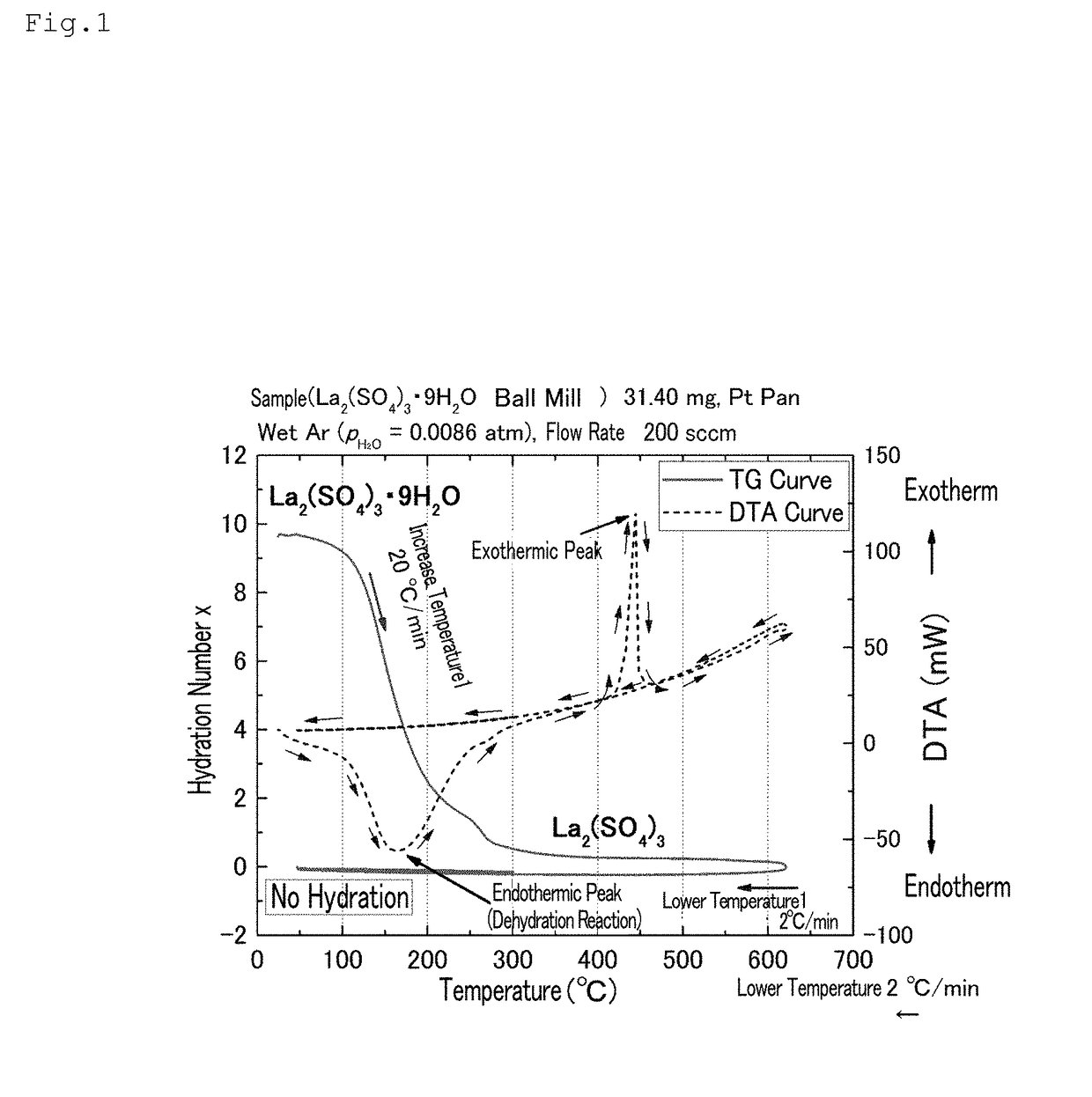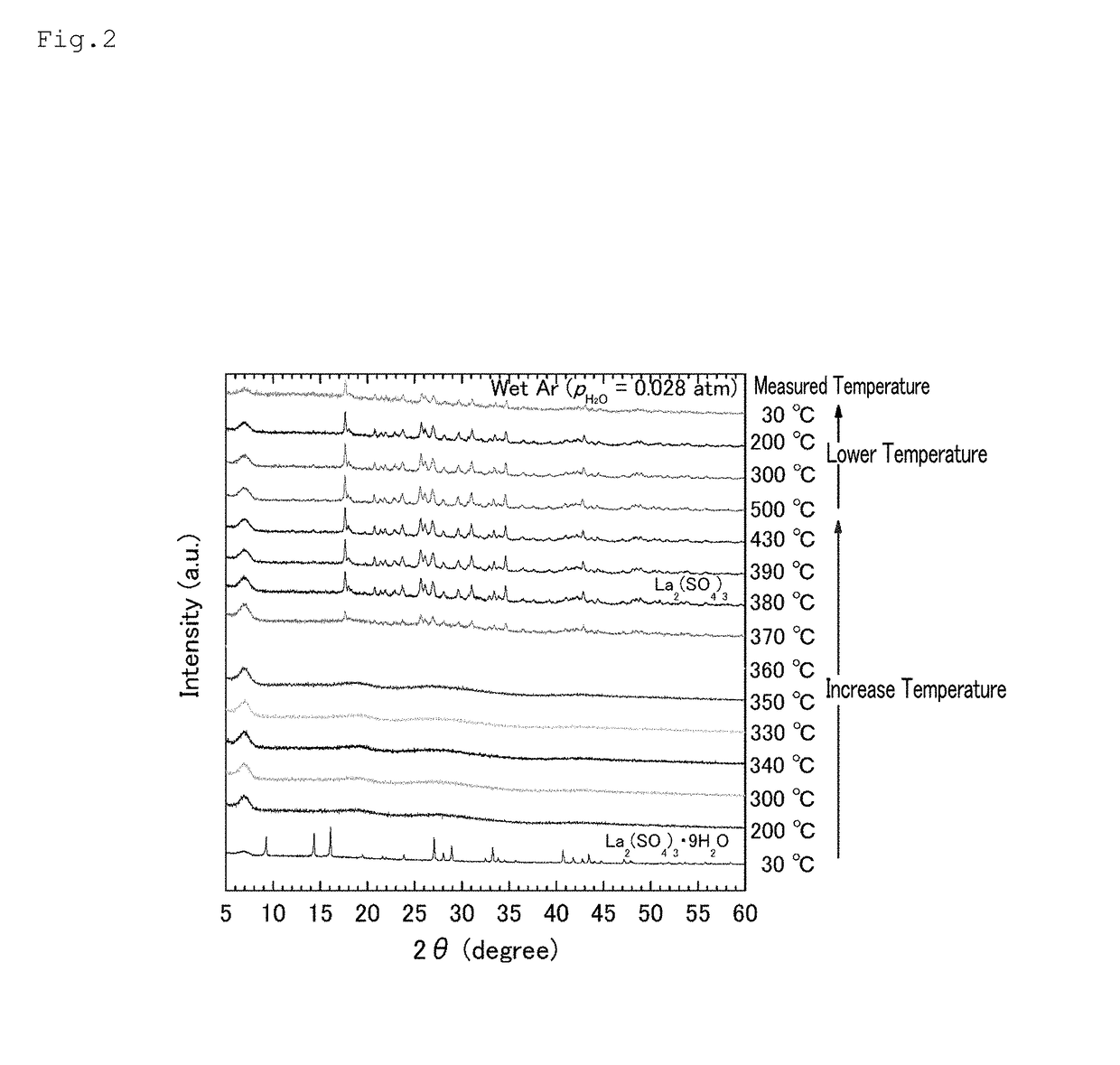Hydrate of Rare Earth Metal Sulfate, Method for Producing Same, and Chemical Thermal Storage Material
a rare earth metal sulfate and hydrate technology, which is applied in the direction of indirect heat exchangers, lighting and heating apparatuses, energy inputs, etc., can solve the problems of hydration reactions, hardly proceeding, and inability to supply heat, etc., to achieve high repeatability, low cost, and high reproducibility in reverse reactions
- Summary
- Abstract
- Description
- Claims
- Application Information
AI Technical Summary
Benefits of technology
Problems solved by technology
Method used
Image
Examples
reference example 1
mogravimetry (TG) of α-Phase Lanthanum Sulfate
[0095]A lanthanum sulfate nonahydrate (Wako Pure Chemical Industries, Ltd.) was pulverized using a ball mill until the average particle size was 2 μm or less. The lanthanum sulfate nonahydrate thus pulverized to have an average particle size of 2 μm or less was heated to 600° C. at a temperature increase rate of 20° C. / min, using a thermogravimetry (TG) measurement device (TG8120: Rigaku Corporation); thereafter, the temperature was lowered to 50° C. at a temperature decrease rate of 2° C. / min (first scanning). In this specification, the average particle size is a value obtained by a known measurement method (for example, measurement using a scanning electron microscope image).
[0096]Subsequently, the temperature was increased to 300° C. at a temperature increase rate of 2° C. / min, and the temperature was lowered to 30° C. at a temperature decrease rate of 2° C. / min (second scanning).
[0097]The inside of the TG device was controlled by dis...
example 1
vimetry (TG) Measurement of β-Phase Lanthanum Sulfate and β-Phase Lanthanum Sulfate Hydrate
[0103]The lanthanum sulfate nonahydrate (Wako Pure Chemical Industries, Ltd.) was used without being pulverized. The lanthanum sulfate nonahydrate was heated to 600° C. at a temperature increase rate of 20° C. / min using a thermogravimetry (TG) measurement device (the same device as that used above); thereafter, the temperature was lowered to 50° C. at a temperature decrease rate of 2° C. / min (first scanning).
[0104]Subsequently, the temperature was increased to 300° C. at a temperature increase rate of 0.2° C. / min, and the temperature was lowered to 30° C. at a temperature decrease rate of 0.2° C. / min (second scanning).
[0105]The inside of the TG device was controlled by distributing humidified argon (Ar) gas inside the device by performing Ar gas-bubbling in water at a constant temperature (Ar (PH2O=0.023 atm), flow rate: 200 sccm).
[0106]FIG. 3 shows the TG measurement results. In FIG. 3, the s...
example 2
erature X-Ray Diffraction (XRD) Measurement of β-Phase Lanthanum Sulfate and β-Phase Lanthanum Sulfate Hydrate
[0114]As in Example 1, a lanthanum sulfate nonahydrate (Wako Pure Chemical Industries, Ltd.) was heated to 500° C. at a temperature increase rate of 20° C. / min. Thereafter, the temperature was lowered to 30° C. at a temperature decrease rate of 20° C. / min. The inside of the device was controlled by distributing humidified Ar gas inside the device by performing Ar gas-bubbling in water at a constant temperature (Ar (PH2O=0.028 atm), flow rate: 200 sccm).
[0115]The X-ray diffraction pattern of sulfuric acid lanthanum sulfate and a hydrate thereof at the various temperatures shown in Table 3 in the temperature increasing and lowering steps were measured using a high-temperature X-ray diffraction (XRD) device (the same device as that used above). The high-temperature XRD was measured using a copper radioactive ray of λ=1.5418 Å passed through a monochromator.
[0116]Table 3 shows t...
PUM
 Login to View More
Login to View More Abstract
Description
Claims
Application Information
 Login to View More
Login to View More - R&D
- Intellectual Property
- Life Sciences
- Materials
- Tech Scout
- Unparalleled Data Quality
- Higher Quality Content
- 60% Fewer Hallucinations
Browse by: Latest US Patents, China's latest patents, Technical Efficacy Thesaurus, Application Domain, Technology Topic, Popular Technical Reports.
© 2025 PatSnap. All rights reserved.Legal|Privacy policy|Modern Slavery Act Transparency Statement|Sitemap|About US| Contact US: help@patsnap.com



